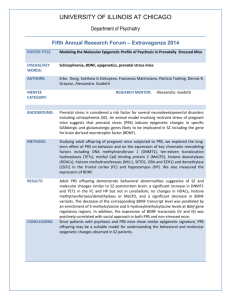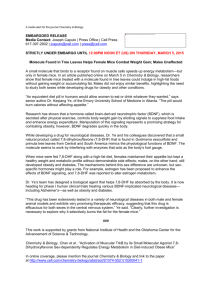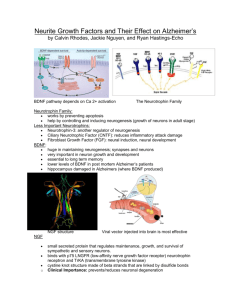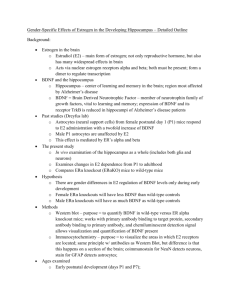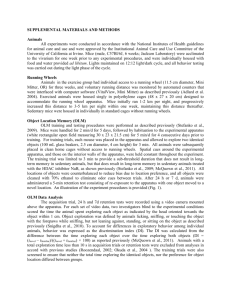Maneeshi Prasad
advertisement
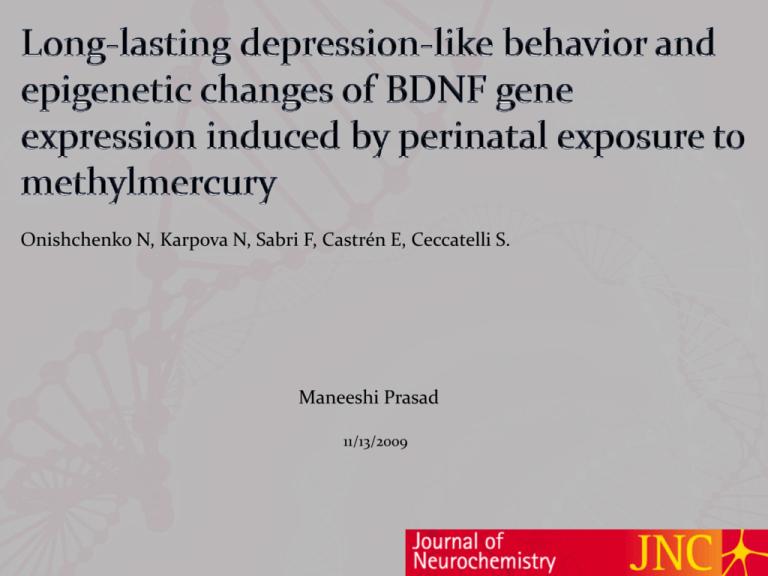
Onishchenko N, Karpova N, Sabri F, Castrén E, Ceccatelli S. Maneeshi Prasad 11/13/2009 Depression • 1 in 6 individual in US is affected from depression during their lifetime • Approximately 18.8 million American adults, or about 9.5 percent of the U.S. population age 18 and older in a given year, have a depressive disorder • Nearly twice as many women (12.0 percent) as men (6.6 percent) are affected by a depressive disorder each year • Depression affects all people regardless of age, geographic location, demographic or social position Depression • Depression often exists with other diseases, including chronic pain, arthritis, diabetes and HIV • Depression is also known to weaken the immune system, making the body more susceptible to other medical illnesses • Anxiety disorders, such as post–traumatic stress disorder (PTSD), obsessive–compulsive disorder, panic disorder, social phobia and generalized anxiety disorder, often accompany depression Causes of Depression • Biochemical. People with depression have physical changes in their brains with neurotransmitters and also could be a culprit may also play a role in depression • Genes. Depression is more common in people who are biologically related to a family member who also has the condition • Environment. Environmental factors such as the loss of a loved one, financial problems and high stress also leads to depression Symptoms of depression Depression symptoms can vary greatly with age. Some common symptoms are: • Loss of interest in normal daily activities • Feeling sad or down • Feeling hopeless • Crying spells for no apparent reason • Problems sleeping • Trouble focusing or concentrating • Difficulty making decisions • Unintentional weight gain or loss • Irritability • Restlessness • Being easily annoyed • Feeling fatigued or weak • Feeling worthless • Loss of interest in sex • Thoughts of suicide or suicidal behavior • Unexplained physical problems, such as back pain or headaches Neural circuitry of depression • Limbic regions have been implicated in depression and antidepressant action • Neural activity in amygdala and subgenual cingulate cortex is highly increased in individuals with depressive symptoms and goes back to normal on successful treatment Neural circuitry of depression Neurotrophins • Depressed patients show volumetric decrease in the hippocampus and forebrain regions • This relates to the decrease in neurotrophic factors • BDNF mediated signaling gets reduced due to stress • Chronic antidepressant treatment increases BDNF mediated signaling • Similar results have been seen in post-mortem hippocampus of patients with depression: low BDNF levels in hippocampus and serum BDNF signaling • BDNF signaling has region and antidepressant specific effect • Antidepressant effects can be inhibited by blocking neurogenesis in hippocampus • Antidepressants increase the amount of growth factors (BDNF, VEGF) that influence neurogenesis in hippocampus Neurotrophic hypothesis of depression • Reduction in brain BDNF levels leads to depression and increase in brain BDNF levels leads to antidepressant action • Antidepressant increase the TrKB activation and signaling – Activation of PLCg signaling • Phosphorylation of CREB – Increase in BDNF transcription BDNF and depression Neurodevelopmental disorders • Learning disabilities, sensory deficits, attention deficit, hyperactivity disorder • Autism and autism spectrum disorders, traumatic brain injury, communication, speech and language disorders • Genetic disorders such as fragile-X syndrome, Down syndrome and Rett syndrome, epilepsy, fetal alcohol syndrome, learning disorders, neurological and psychiatric • Environmental conditions affect expression of genes, resulting in long lasting changes in structure and function of brain – Stress – Drug treatments – Maternal care – Toxins e.g.: Methyl mercury Environmental contaminant present in sea food How People Are Exposed to Mercury • Eating fish or shellfish that is contaminated with methylmercury, which is the main source of general human exposures to mercury • Breathing air contaminated with elemental mercury vapors (e.g., in workplaces such as dental offices and industries that use mercury or in locations where a mercury spill or release has occurred) • Having dental fillings that contain mercury; and • Practicing cultural or religious rituals that use mercury. How Mercury Affects People’s Health • Short-term exposure to extremely high levels of elemental mercury vapors can result in lung damage, nausea, diarrhea, increases in blood pressure or heart rate, skin rashes, eye irritation, and injury to the nervous system • Prolonged exposure to lower levels of elemental mercury can permanently damage the brain and kidneys • The developing brain of a fetus can be injured if the mother is exposed to methylmercury Levels of Mercury in U.S. Population • Survey period of 2005–2006: 95th percentile levels for total blood mercury in children aged 1-5 years and females aged 16-49 years were 1.43μg/L and 4.48 μg/L, respectively i.e. only 5 percent of the population will have values at this level or higher Mercury on neurodegeneration http://www.epa.gov/mercury/effects.htm http://www.epa.gov/mercury/advisories.htm Long-lasting depression-like behavior and epigenetic changes of BDNF gene expression induced by perinatal exposure to methylmercury Experimental Animals and methods • C57BL/6/Bkl mice – Pregnant dams exposed to MeHg @ 0.5mg/kg/day via drinking water from gestational day 7 till day 7 after delivery – No change in litter size, body weight gain – Results in brain mercury concentration similar to infants in human population who eat MeHg contaminated fish In-situ hybridization, ChIP, Primer extension, Densitometry Forced swim test • Animals starting at 9 weeks were tested • Individuals were tested for immobility for 6min after a pretest of 15min 24hrs before the test • Immobility- passively floating in water for 2sec or longer with only small movements enough to keep the head above water Results: Depression-like behavior of MeHg-exposed mice Results of FST • Immobility time was longer in perinatally MeHg-exposed mice than controls of 9 weeks, 12 weeks and 14 months • Confirming the long-lasting effect of MeHg • Treatment with fluoxetine (Prozac) reduced the immobility time in the MeHg treated animals Hippocampal BDNF mRNA level TrKB mRNA expression Results of BDNF mRNA expression levels • MeHg lead to significant decrease in BDNF mRNA level in dentate gyrus but not in CA1 and CA3 regions of 12 week old mice and persisted in 14-month old mice • No change was seen in TrKB mRNA expression in the hippocampal formation • Fluoxetine treatment was able to restore the BDNF mRNA expression in dentate gyrus Epigenetic regulation in depression. H3K27-methylation : no transcription H3K9 and H3K14- acetylating: transcription Chromatin Immunoprecipitation (ChIP) BDNF Gene locus with 8 promoters Epigenetic state of BDNF gene H3K27 methylation and H3 acetylation regulate BDNF gene expression in hippocampus • Increased H3K27 tri-methylation and decrease in histone H3 acetylation at the BDNF promoter IV of 12 week old mice that persisted through 14-month old MeHg exposed mice leading to silencing of BDNF gene • Fluoxetine treatment had no effect on the H3k27 trimethylation but it did increase the histone H3 acetylation to overcome the repression of BDNF transcription Methylation of CpG sites • Using MS-SNuPE (Methylation Sensitive Single Nucleotide Primer Extension) DNA treated with bisulphite to convert unmethylated cytosine converted to uracil Primer extension with P32 labeled TTP and CTP, extension will end just 5’ to the C or U Quantification of CTP/TTP ratio to estimate the amount of methylated C Methylated CpG result in repression of transcription Epigenetic state of BDNF gene Epigenetic state of BDNF gene • Significant increase in DNA methylation at BDNF promoter IV in hippocampus was seen in 14 month old mice exposed to MeHg prenatally Discussion • Previous studies have shown that MeHg exposure during developmental stages have behavioral effects in rodent animal models similar to depression • Current data confirms the role of MeHg in incorporating long term epigenetic changes in BDNF gene locus leading to depression-like symptoms in mice model exposed to MeHg prenatally • Antidepressant treatment was able to overcome this MeHg induced repression of BDNF expression in the hippocampus Discussion • Impairment in memory, attention, language and visuospatial perception has been seen in children exposed to MeHg prenatally • Depressive syndromes have been seen in adults with occupational exposure to mercury • These patients have reduced hippocampal and serum BDNF levels, which can be restored by antidepressant treatment Prozac (selective 5-HT reuptake inhibitor) Discussion • During depression there is decrease in BDNF mRNA in dentate gyrus • BDNF expression has been associated with increase in neurogenesis in the subgranular zone of dentate gyrus • Suggesting that MeHg may be involved in decrease in neurogenesis Discussion • Promoter IV of BDNF gene is regulated by neuronal activity (CaRF and CREB) • MeHg was able to induce long lasting epigenetic changes in this promoter in the hippocampus by methylation of H3K27 and decrease in acetylation of H3 • Antidepressant was able to increase the acetylation of H3 at this promoter to relieve the MeHg induced repression of BDNF gene expression • Antidepressants may act through downregulation of histone deacetylases resulting in increased acetylation of histones and thus gene transcription

